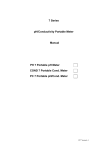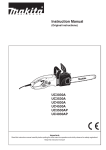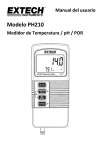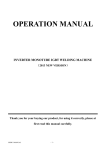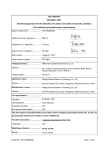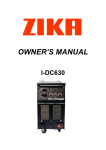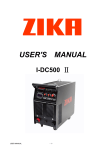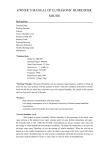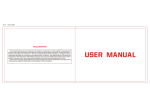Download User manual - XS Instruments
Transcript
Model pH50 Lab. pH Meter Manual 1. Brief Introduction: Thanks for purchasing and using Model pH50 Lab pH Meter (referred to “meter” as below). Before using this meter, please read the manual carefully in order to use and maintain it properly. On the basis of improving instrument performance constantly, we reserve the right to change the manual and accessories without giving notice in advance. This meter is perfect combination of the most advanced electronic, sensor technology and software design, and is the most cost effective lab. pH meter suited for industrial and mining enterprises, school and scientific research. The meter has the following prominent features: 1.1. There are intelligent functions such as automatic calibration, automatic temperature compensation, data storage and self-diagnose information, etc. 1.2. Adopt advanced digital handling technology to improve the response speed of the meter and result accuracy. “ ” will appear when reading is stable. 1.3. 1-3 points automatic calibration, automatically recognize pH buffer solution. There are functions of calibration instruction, automatic checking and error display. Automatically display electrode slope percentage after calibration. 1.4. Large blue backlit display screen. Simultaneous display of pH value and temperature value. 1.5. Two options of temperature units ℃ and ℉. 1.6. Equipped with plastic pH three-in-one combination electrode, flexible electrode holder and pH buffer solution, more convenient to use. 2. Technical Specifications: 2.1. pH: Range (0.00~ 14.00)pH Resolution 0.01 pH 1 pH 50 Version1.0 2012-9-7 Accuracy Meter:±0.01pH±1digit;Meter with electrode:±0.02pH±1 digit Stability ±0.01pH±1 digit/3h ATC (0 ~ 100)℃(automatic or manual) Range ±1999mV Resolution 1mV Stability ±0.1% FS±1 digit 2.2. mV: 2.3. Temperature: Range 0~ 100℃ Resolution 0.1℃ Stability 5~ 60℃:±0.5℃, Other range:±1℃ 2.4. Other technical specifications: Data storage Storage content Power Dimension & Weight Certificate 25 groups Measured value serial number, measured value, temperature value,ATC or MTC. DC9V power (160×190×70)mm / 750 g ISO9001:2008, CE and CMC 3. Introduction to Meter: 3.1. LCD display: 2 pH 50 Version1.0 2012-9-7 ①——Measured value ②——Measurement unit ③—— Temperature compensation icon: ATC — automatic temperature compensation MTC — manual temperature compensation ④——Temperature measured value and measurement unit ⑤——Calibration icon ⑥——Storage and recall icon STORE —Measured value storage icon;RECALL —Measured value echo icon ⑦——Measured value stabilization icon. 3.2. Operation keys: There are seven operation keys for the meter: 3.2.1. —Switch key. 3.2.2. —Key for both calibration and measurement. (a) Under measurement mode, press this key to enter into calibration mode, (b) Under other mode, press this key to enter into measurement mode. 3.2.3. 3.2.4. — Storage and recall key for storage and recall of measured value. —Plus and Minus key. 3 pH 50 Version1.0 2012-9-7 For manual temperature compensation, press plus or minus key, press one time to change 0.1℃ each time, press continuously to change temperature rapidly. 3.2.5. —Switch key for pH and mV. 3.2.6. —Confirmation key. 3.3. Socket: 3.3.1. “pH/mV” socket — when measuring pH, connect 201T-F plastic pH electrode to the meter, when measuring mV, connecting ORP electrode or various ion selective electrode to the meter (Attention: BNC connector). After measurement, please cover the socket by the short-circuit protection cap to maintain the socket clean. 3.3.2. “Temperature” socket — Connect the temperature connector of 201T-F plastic pH three-in-one combination electrode or PHT temperature probe to the meter. When connecting temperature probe to the meter, the meter is under the state of automatic temperature compensation and can test the temperature of solution; when removing the temperature probe, the meter is under the state of manual temperature compensation and temperature can be adjusted by pressing or key. 3.3.3. “ REF” socket — Connect reference electrode when using non-combination pH or ion electrode. 3.3.4. “DC9V” power connector — Connect DC9V power adapter. 4. Using Method: 4.1. pH Test: 4.1.1. Connect power, press key to turn on the meter. 4.1.2. Take off the short-circuit protection cap, insert the two connectors of three-in-one combination electrode into pH and temperature sockets respectively, dip the electrode with pure water and shake off water on the electrode. 4.1.3. The 1st point calibration: 4 pH 50 Version1.0 2012-9-7 a) Press to enter into calibration mode, “CAL” and “7.0” appear on the bottom of LCD, indicating using pH 7.00 buffer solution to make the 1st point calibration. b) Place pH electrode in pH7.00 buffer and stir a while and place it still, “7.0” appears at the bottom right of LCD, indicating that the meter recognizes pH7.00 buffer solution. C) Wait for a moment until appears at the top left, press , calibration is done when measured value twinkles three times on LCD. Display stable pH calibration value on LCD, meanwhile, “CAL” icon is twinkling at the bottom of LCD and “4.0”and“10.0” is displayed alternately, indicating using pH4.00 or pH10.01 buffer solution to make the 2nd point calibration. 4.1.4. The 2nd point calibration: a) Take out pH electrode,rinse it with pure water and shake off water on the electrode. Then place pH electrode in buffer solution pH 4.00, stir a while and place it still. Then display stable“ 4.0 ”at the bottom right of LCD, indicating the meter recognizes pH4.00 buffer solution. b) Wait for a moment until appears at the top left, press , calibration is done when measured value twinkles three times on LCD. First display slope percentage, then display stable pH calibrated value on LCD, meanwhile, “CAL” icon and“10.0”are twinkling at the bottom of LCD , indicating using pH10.01 buffer solution to make the 3rd point calibration. 4.1.5. The 3rd Calibration: a) Take out pH electrode, clean it with pure water and dry it. Then place pH electrode in buffer solution pH 10.01, stir a while and place it still. Then display stable“ 10.0 ”at the bottom right of LCD, indicating the meter recognizes pH10.01 buffer solution. b) Wait for a moment until appears at the top left, press , calibration is done when measured value twinkles three times on LCD. First display slope percentage, then display stable pH calibrated value on LCD, Finally calibration is done and the meter enters into the measurement mode. 5 pH 50 Version1.0 2012-9-7 4.1.6 Sample test: Place pH electrode in the sample after rinse, stir a while and place it still. Get the reading value when the measured value is stable. 4.1.7. Illustration: a)This meter can be calibrated automatically by one-point, two-point, or three-point. If the required accuracy is ≤ ±0.1pH, user only needs to perform one-point calibration with pH 7.00 buffer solution. If the measuring range is only within acid range (pH<7.00), user can perform two-point calibration with pH 7.00 buffer solution and pH 4.00 buffer solution. If measuring range is only within alkaline range (pH>7.00), user can perform two-point calibration with pH 7.00 buffer solution and pH 10.01 buffer solution. If the measuring range is wide or the electrode has been used for long time, user should perform three-point calibration to get the accurate reading. Please note for initial use of pH electrode, user should perform three-point calibration in order to ensure that the meter slope is the same as pH electrode slope. b) When the 1st point calibration is done, press to confirm, the meter enters into the measurement mode of the 1st point calibration. When the 2nd point calibration is done, press to confirm, the meter enters into the measurement mode of the 2nd point calibration. When the 3rd point calibration is done, the meter enters into the measurement mode of the 3rd point calibration. c) If uses pH combination electrode without temperature sensor, please place pH electrode and temperature probe (need purchase separately) in the electrode clip, make ATC pH calibration and testing, or make manual temperature compensation, press or to adjust temperature. d) When place pH combination electrode in the solution, stir a while and place it still which can speed up the response of the electrode. Especially when use plastic pH combination electrode, stir it more forcefully since there is a small cavity between the protection cap of the electrode cap and pH glass bulb, which easily causes bubbles and leads to bad contact 6 pH 50 Version1.0 2012-9-7 with solution. Therefore, stir enough to ensure to remove bubbles, or take off the protection cap of the electrode head and then make testing. But be careful not to damage glass bulb. e) According to the isothermal measuring principle, the more close the temperature of sample solution to that of the buffer solution, the higher accuracy of measuring can be obtained. Please comply with the principle during measurement. f) During the process of calibration and measurement, the meter has self diagnosis functions, indicating the relative information as the below: Display Content Checking Icons The recognition range of calibration solution exceeds standard. Electrode zero electric potential exceeds standard. (<-60mV or >60mV). Electrode slope exceeds standard. (<70% or >120%) 1. Check whether pH buffer solution is correct. 2. Check whether the meter connects the electrode well. 3. Check whether the electrode is damaged. 1. Check whether there are bubbles in glass bulb. 2. Check whether pH buffer solution is correct. 3. Replace with new pH electrode. Operation when measurement Re-press when appears. is not stable. 1. Check whether there are bubbles in glass bulb. 2. Replace with new pH electrode. The measured value is not stable. pH measuring range exceeds standard ( <0.00 pH or >14.00pH). mV measuring range exceeds standard (<-1999 mV 7 1. Check whether the electrode is suspended. 2. Check whether the meter connects the electrode well. 3. Check whether the electrode is damaged. pH 50 Version1.0 2012-9-7 或>1999 mV). 4.2. mV value measurement: 4.2.1. Press key, and switch meter to mV measurement mode. 4.2.2. Connect ORP electrode or ion electrode (need purchase separately) and place it in sample solution, stir it a while and place still, get the reading when the measured value is stable, which is ORP value or electric potential of the ion electrode. 4.3. Other Operation Instructions: 4.3.1. Storage/Recall: a) Storage: Under measurement mode, press to store measured value, “ STORE ” icon and storage number (1.2.3┈ 25) are displayed on LCD, indicating the measured value is stored under the storage number, and return to the normal mode immediately. This meter can store 25 measured values, and the 1st measured value is replaced with the 2nd measured value if the storage exceeds 25 numbers. b) Recall: Press for two seconds, “RECALL” icon and the last storage number are displayed on LCD, then display the measured number, then press and , display alternately the storage number and the measured value. c) Exit: Under the state of “RECALL”, press to exit from the storage program, then “RECALL” icon on LCD disappears. d) Clean away: Under the state of “ RECALL ” , press for five seconds to eliminate all storage data. 4.3.2. Two options of ℃ and ℉: press for a few seconds to select ℃ or ℉. 4.3.3. Restore to factory default: press for five seconds, the meter restores to factory 8 pH 50 Version1.0 2012-9-7 default. When the meter calibration or display is not normal, please restore the meter to factory default, then try re-calibration. 5. Attention: 5.1. Frequency of meter calibration depends on the sample, electrode performance and required accuracy. For high accurate measurement (≤±0.02pH), please make calibration on time and use the buffer solution of high accuracy. For general accuracy measurement (≤±0.1pH), the meter can be used for one week or even longer once calibrated. However, the meter must be re-calibrated under the following situations: (a) Electrode unused for a long time and new electrode. (b) For measurement of concentrated acid (pH<2) or concentrated alkaline (pH>12) solution. (c) For measurement of solution with fluoride and concentrated organic solution. (d) The temperature of tested solution is much different from calibration temperature. 5.2. There is some soaking solution in the protection bottle at pH electrode head, the electrode head is soaked in the soaking solution to keep the glass bulb and junction activated. Take off the cap when measuring and rinse the electrode with pure water. After measuring, re-place the electrode in the protection bottle and put the cap on. If the soaking solution becomes turbid or mouldy, please clean the bottle and renew the soaking solution. 5.3. How to make the electrode soaking solution: take 30g pure KCL, dissolve it in 100mL pure water. Avoid dipping the electrode in pure water, protein solution and acid fluoride solution for long time, and avoid contact with organic lipa. 5.4. When calibrate meter with known pH standard buffer solution, in order to improve the measuring accuracy, pH value of buffer solution should be reliable. The buffer solution should be renewed in time after frequently used. 5.5. Keep the meter clean and dry, especially keep meter and connector clean and dry, avoid inaccurate measuring or invalidation. If the electrode gets dirty, clean it with cotton and alcohol, and then dry it. 9 pH 50 Version1.0 2012-9-7 5.6. The sensitive glass bulb at the head of the combination electrode should not touch hard objects; any damage will invalidate the electrode. Before and after measuring, rinse the electrode with pure water and shake off the water on the electrode. Please do not wipe the glass bulb with tissue paper which leads to unstable electric potential of the electrode and prolong response time. After measuring sticky sample, please rinse the electrode with pure water repeatedly to remove the sample stuck on the electrode, or clean it with suitable dissolvent first, and then rinse it with pure water. 5.7. When an electrode has been used for long time, the electrode will get passivated. For example: the electrode is not sensitive, the response is low or the reading is not accurate. The reason is that some measured solution contains substance, contaminating the sensitive glass bulb, or causing jam in the junction. In this case, please take measures accordingly: (a) The glass bulb is contaminated and aged: dip the electrode into 0.1mol/L diluted hydrochloric acid (Preparation: dilute 9mL hydrochloric acid with pure water 1000mL) for 24 hours. Rinse it with pure water, then dip it in the soaking solution for 24 hours. For serious passivation, place the bottom of the electrode in 4%HF (hydrofluoric acid) for 3 to 5 seconds, rinse it with pure water, then dip it in the soaking solution for 24 hours to renew its performance. (b) How to clean contaminated glass bulb and junction: (For reference) Contaminant Abluent Inorganic metal oxide Dilute acid (<1mol/L) Organic lipa Dilute abluent (alkalescence) Resinic macromolecule Protein haematocyte sediment Dilute alcohol, acetone, ether Acidic enzymatic solution (such as yeast) Pigment Dilute bleacher, peroxide The material of electrode housing is polycarbonate. Please use with caution the abluent such as tetrachloromethane, trichloroethylene, tetrahydrofuran and acetone because these abluents can dissolve polycarbonate, which leads to the electrode invalidation. 5.8. The lifetime of pH electrode is about one year, but will be shortened due to bad 10 pH 50 Version1.0 2012-9-7 condition of usage or incorrect maintenance. Replace with a new electrode in time when the electrode is aged or invalidated. The built-in chip of the meter can detect electrode slope automatically (please see the details at the item 4.1.4 and 4.1.5). If the slope is less than 70%, please activate the electrode (see the details at the item 5.7) or replace with a new electrode. 6. Meter Kit: 6.1. Model pH50 pH meter 1set 6.2. 201T-F plastic pH three-in-one combination electrode 1pc 6.3. pH4.00、7.00、10.01 buffer solution(each 50mL) 1 bottle 6.4. 9V power adapter 1pc 6.5. Model 602 flexible electrode holder 1pc 6.6. Manual 1book 7. Warranty: 7.1. Under the normal condition of usage within one year since the purchase date, the repair, replacement of the parts or the product is free of charge if the instrument fails to work because of manufacturing defects. 7.2. pH electrode is not under warranty. But if new pH electrode unused does not work, the repair or the replacement is free of charge. 7.3. This warranty does not apply to the damages which result from improper usage, improper maintenance or unauthorized repair by the user. 11 pH 50 Version1.0 2012-9-7












